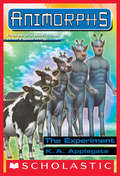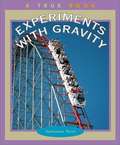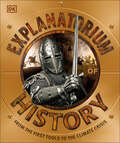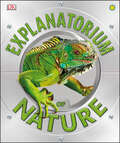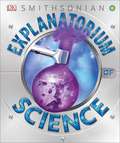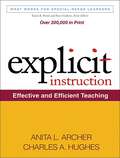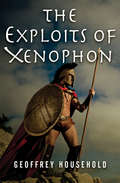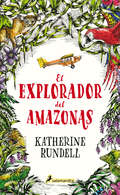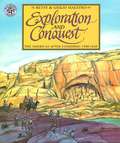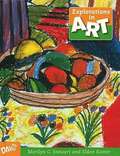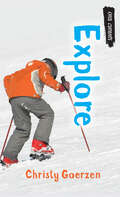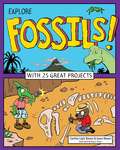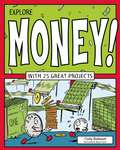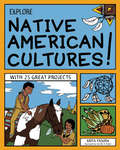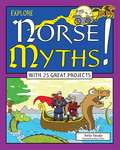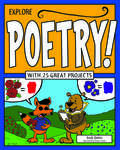- Table View
- List View
The Experiment (Animorphs #28)
by K. A. ApplegateThe Yeerks have decided to try a little experiment. They've decided that if they can develop a way to make people more "willing" to be infested, they can speed up Earth's invasion. So the Yeerks try to invent a substance that will take away the human ability to make a decision. A substance that will eliminate free will. Now the Animorphs are not only faced with trying to slow down the Yeerks' invasion, but they also have to put an end to the genetic testing on a small group of humans. This time there's only one chance to stop the Yeerks. And if anything goes wrong, it's all over...
Experimenting with Forces and Motion, Student Guide
by National Science Resources Center Dane J. Toler Taina LitwakNIMAC-sourced textbook
Experimenting with Mixtures, Compounds, and Elements, Student Guide
by National Science Resources Center Kitty Lou Smith Susie DuckworthNIMAC-sourced textbook
Experiments with Gravitie (True Books: Science Experiments)
by Salvatore TocciLearn about gravity through a series of nine different experiments.
Experiments with Plants: Student Investigations
by National Science Resources CenterNIMAC-sourced textbook
Experiments with Plants: A True Book
by Salvatore TocciNine easy-to-follow experiments help readers explore what a plant is, what it needs to grow and live, what's inside a plant seed, and how seeds grow and get spread in the wild.
Explanatorium of History: From the First Tools to the Climate Crisis (DK Explanatorium)
by DKDiscover the story of &“us&” — from the dawn of human history up to the world we live in today.This visually stunning history encyclopedia for children takes you on an epic fact-packed journey through the past. Explore historical events through vivid illustrations and engaging explanations.Inside the pages of this fascinating history book for kids ages 10-14, you&’ll find: • Gorgeous images of objects, paintings and landscapes that bring history to life. • In-depth information using targeted captions and annotation. • Supporting artwork panels allow for a deeper understanding. • Comprehensive historical reference. Welcome to the SI Explanatorium. Take a look inside to reveal how history works! From the evolution and migrations of early humans to the rise and fall of great empires like Ancient Rome and the Aztecs, this history reference book shows you the major turning points in history.Get the inside track on wars and conflict, including European knights, Japanese samurai, Inca warriors and the major clashes of World War I, World War II, the Cold War, the War on Terror and so much more. It&’s the perfect children&’s visual encyclopedia for young history buffs.There are more SI Explanatoriums to explore! Get closer to nature than you&’ve ever been before with SI Explanatorium of Nature and see the world of science come to life with SI Explanatorium of Science.
Explanatorium of Nature (DK Explanatorium)
by DKGet closer to nature than you&’ve ever been before with this jaw-dropping guide to our wonderful world. Marvel at the breathtaking photography showcasing flora and fauna in the most incredible, intricate detail. From ants to elephants, the animal kingdom is explored and explained in this extraordinary encyclopedia that puts you at the heart of the action. See the tiny spines on a stinging nettle, watch lichen spreading over a tree, and observe the secret suckers on an iguana&’s feet. The mysteries of the natural world are displayed in brand new images, together with cross-sections, macro, and electron microscope images. Alongside the utterly absorbing visual content, Explanatorium of Nature brings its own fountain of knowledge about how nature works. For instance, did you know baby foxes that are born with blue eyes turn to gold? Or that reptile scales are made from the same material as your fingernails? Discover how spiders spin webs, how birds fly, how snakes kill, and much, much more. This irresistible book is a guaranteed favorite for animal lovers, nature enthusiasts, and budding wildlife experts everywhere.
Explanatorium of Science
by Dk Smithsonian InstitutionOpen up this book to reveal how science really works! Watch as mixtures merge and matter changes state. Discover how some chemical changes can be reversed, yet others can't, and why some reactions produce a bang! See bacteria at work in the world around us, and even inside the human digestive system. Understand the tricks that light plays and unlock the secrets of electricity to find out how it powers your home.
Explicit Instruction: Effective and Efficient Teaching (What Works for Special-Needs Learners)
by Anita L. Archer Charles A. HughesExplicit instruction is systematic, direct, engaging, and success oriented--and has been shown to promote achievement for all students. This highly practical and accessible resource gives special and general education teachers the tools to implement explicit instruction in any grade level or content area. The authors are leading experts who provide clear guidelines for identifying key concepts, skills, and routines to teach; designing and delivering effective lessons; and giving students opportunities to practice and master new material. Sample lesson plans, lively examples, and reproducible checklists and teacher worksheets enhance the utility of the volume. Purchasers can also download and print the reproducible materials for repeated use. Video clips demonstrating the approach in real classrooms are available at the authors' website: www.explicitinstruction.org. See also related DVDs from Anita Archer: Golden Principles of Explicit Instruction; Active Participation: Getting Them All Engaged, Elementary Level; and Active Participation: Getting Them All Engaged, Secondary Level
Exploding Ants
by Joanne SettelA wasp lays its eggs under a caterpillar's skin so that its young can eat the caterpillar's guts as they grow. A young head louse makes its home on a human hair and feasts on human blood. Frogs use their eyeballs to help swallow their food. From small worms that live in a dog's nose mucus to exploding ants to regurgitating mother gulls, this book tells of the unusual ways animals find food, shelter, and safety in the natural world. If animals all ate the same things and lived in the same places, it would be impossible for all of them to survive. So they specialize. Some animals eat the bits that others leave behind, such as skin and mucus. They find all kinds of unusual places to shelter, including the cracks and holes in another creature's skin or its internal organs. They use their own bodies to protect themselves from predators by imitating unsavory items such as bird droppings and even by blowing up. These habits that may seem disgusting to us are wonderful adaptations that make it possible for a great variety of creatures to live and thrive on Earth. Read about them and marvel at the amazing ways animals adapt to the natural world.
The Exploits of Xenophon
by Geoffrey HouseholdThousands of miles from home, one soldier leads an army to safety The war with Sparta is over, and Athens is at peace for the first time in thirty years. Their Greek enemies subdued, the generals of Athens turn their eyes to the East, where the Persian Empire stretches to the edge of the known world. Never before have Greek soldiers marched into Persia. Xenophon will be among the first. A warrior whose bravery is matched only by his intelligence, Xenophon is a natural leader. When his army of ten thousand men is stranded far from home, it is up to him to lead them back to Greece without sacrificing the principles of democracy that they hold so dear. A retelling of Xenophon's classic Anabasis, this is a thrilling tale of bravery and survival, in which the mind is as valuable a weapon as the sword.
El explorador del Amazonas
by Katherine RundellUna novela sobre el valor de la amistad protagonizada por unos niños perdidos en la selva amazónica. Desde su asiento en un avión de seis plazas, Fred observa cómo los misterios de la selva amazónica pasan bajo sus pies. Siempre ha soñado en convertirse en un explorador, hacer historia y leer su nombre como uno de los grandes descubridores de su tiempo, así que piensa que ojalá pudiera aterrizar y pisar tierra, aunque fuera sólo un minuto. Cuando, a causa de un accidente, el avión se estrella, Fred podrá por fin caminar por la selva, pero no en las condiciones que había imaginado. Lila, Max y Contia, otros tres niños supervivientes, no tienen ninguna esperanza de ser rescatados de ese lugar inmenso e indómito donde las opciones de volver a casa se reducen a las mínimas posibilidades. La crítica ha dicho...«Un libro absolutamente maravilloso.»Philip Pullman
Exploration And Conquest: 1500-1620
by Betsy Maestro Giulio MaestroChristopher Columbus was not the first to discover the Americas, but his voyages led to European exploration of the New World. Rich in resources and natural beauty, the Americas were irresistible to gold-hungry conquistadors. The newcomers gave little thought to those who had called the lands their home, and exploration soon came to signify conquest. The New World -- and the lives of its inhabitants -- would be changed forever.
Explorations in Art [Grade 5]
by Marilyn G. Stewart Eldon KatterIncludes six units, each organised around a universal theme relevant to students' lives; these themes foster meaningful connections to artworks across time and place. This book also features elements and principles that are embedded throughout each unit to ensure continual application and understanding.
The Explorations of Pere Marquette
by Jim KjelgaardThis book presents the adventures of a real hero, greater than those created by fiction.
Explore (Orca Currents)
by Christy GoerzenWhen Mike Longridge gets himself in trouble yet again, he is given a choice: juvenile detention or an outdoor program called Explore. He opts for Explore, but soon finds himself wondering how he is going to survive ten months with the hippies and keeners in the program. He's never felt so out of place and is certain he will never get the hang of the outdoor activities. Will Mike go back to his old trouble-making ways or will he finally find a place to belong?
Explore Fossils!
by Cynthia Light Brown Grace BrownIn Explore Fossils! With 25 Great Projects, readers can expand their dinosaur obsessions into learning opportunities that take them beyond Triceratops, Stegosaurus, and even Tyrannosaurus rex to other animals, plants, and microbes that lived long before humans. Explore Fossils! introduces young readers to the history of life on Earth as revealed by fossils. Kids learn how fossils form and about the different types of fossils and the world of long ago--its landscape and the plants and animals that lived then. Scientists use radiometric dating to test fossils to discover when they were made, what organisms made them, what those organisms used for energy, what killed them, and a whole lot of other information. All from rocks! That's a lot of information stored under our feet. Activities include creating plaster fossils, using popcorn to illustrate radiometric dating, and exploring what might have caused mass extinctions by making a lava flow and simulating an asteroid impact. By studying the past, not only do students meet amazing plants and animals, they are also encouraged to consider their own role in geological time to make thoughtful hypotheses about the future.
Explore Money!
by Cindy Blobaum Bryan StoneIn Explore Money! With 25 Great Projects, money is more than something to earn, save, and spend. It's an opportunity to explore history, art, science, economics, and math! While checking out the change in their pockets and bills from their banks, young readers search for hidden treasures, learn how money can multiply, and see how countries keep their currency secure. Very large and very small numbers take on a new relevance when seen through the lens of money. Using familiar materials found in the home or classroom, young readers explore the cultural aspect of money as well as its physical properties, discovering how these properties have affected business and global relationships throughout history. Kids experiment with various substances to clean coins, scientifically test coin components, design their own currency, and plan how to allocate their own money. Understanding the whats, whys, and hows of currency helps children achieve financial literacy and establish a strong foundation for a healthy, life-long relationship with money. Explore Money! meets Common Core State Standards for literacy in language arts, and mathematics; Guided Reading Levels and Lexile measurements indicate grade level and text complexity.
EXPLORE NATIVE AMERICAN CULTURES!
by Anita Yasuda Jennifer KellerExplore Native American Cultures! with 25 Great Projects introduces readers to seven main Native American cultural regions, from the northeast woodlands to the Northwest tribes. It encourages readers to investigate the daily activities-including the rituals, beliefs, and longstanding traditions-of America's First People. Where did they live? How did they learn to survive and build thriving communities? This book also investigates the negative impact European explorers and settlers had on Native Americans, giving readers a glimpse into the complicated history of Native Americans.Readers will enjoy the fascinating stories about America's First People as leaders, inventors, diplomats, and artists. To enrich the historical information, hands-on activities bring to life each region's traditions, including region-specific festivals, technology, and art. Readers can learn Native American sign language and create a salt dough map of the Native American regions. Each project is outlined with clear step-by-step instructions and diagrams, and requires minimal adult supervision.
Explore Norse Myths!
by Anita YasudaThe stories of Norse myths and legends are a terrific introduction to Viking culture, history, science, and traditions, which thrived in Scandinavia from the eighth to the eleventh centuries. But who were the Norse, who left their homelands in Denmark, Norway, and Sweden to trade, raid, and explore around the world? In Explore Norse Myths! With 25 Great Projects, young readers discover the remarkable people and mythical creatures of old. Learning about Norse myths means unearthing the origin of Viking beliefs, as well as exploring their ships, tools, and other technology that flourished for nearly 450 years. Along the way, kids will read how Norse myths helped explain the natural world from thunder to the seasons, from creation to death. They may be surprised at how Norse myths continue to influence modern culture in the form of movies and books, including the new series by Rick Riordan. Readers will read Norse stories and learn about the adventures of real Norse explorers, including Erik the Red and Leif Erikson. Through a mixture of fun facts, trivia, jokes, comics, and hands-on activities, kids will dig up Scandinavia's past and sail the seas along with the gods and giants in Explore Norse Myths!
Explore Poetry!
by Andi DiehnPoems can be silly, serious, or fun, just like kids! Whether it’s the sing-song rhythm of a limerick, the serendipitous magic of a found poem, the deceptive simplicity of a haiku, or the easy familiarity of an acrostic poem, children are charmed by poetry. And what’s more fun than reading poetry? Writing it! In Explore Poetry! With 25 Great Projects children have fun learning about different forms of poetry while delving into different literary techniques such as personification, metaphor, and alliteration, all of which are discussed in a simple and accessible way. Activities include creative writing exercises designed to reinforce language arts skills, plus art projects that encourage children to visualize concepts and definitions. Short biographies of important poets reinforce the concept of poetry as an important part of society. Explore Poetry! meets Common Core State Standards for language arts; Guided Reading Levels and Lexile measurements indicate grade level and text complexity. Informational and inspiring, Explore Poetry! fits seamlessly into the poetry curriculum of grades 2 to 4 and serves as an enrichment resource all during the school year, especially April, Poetry Month.
